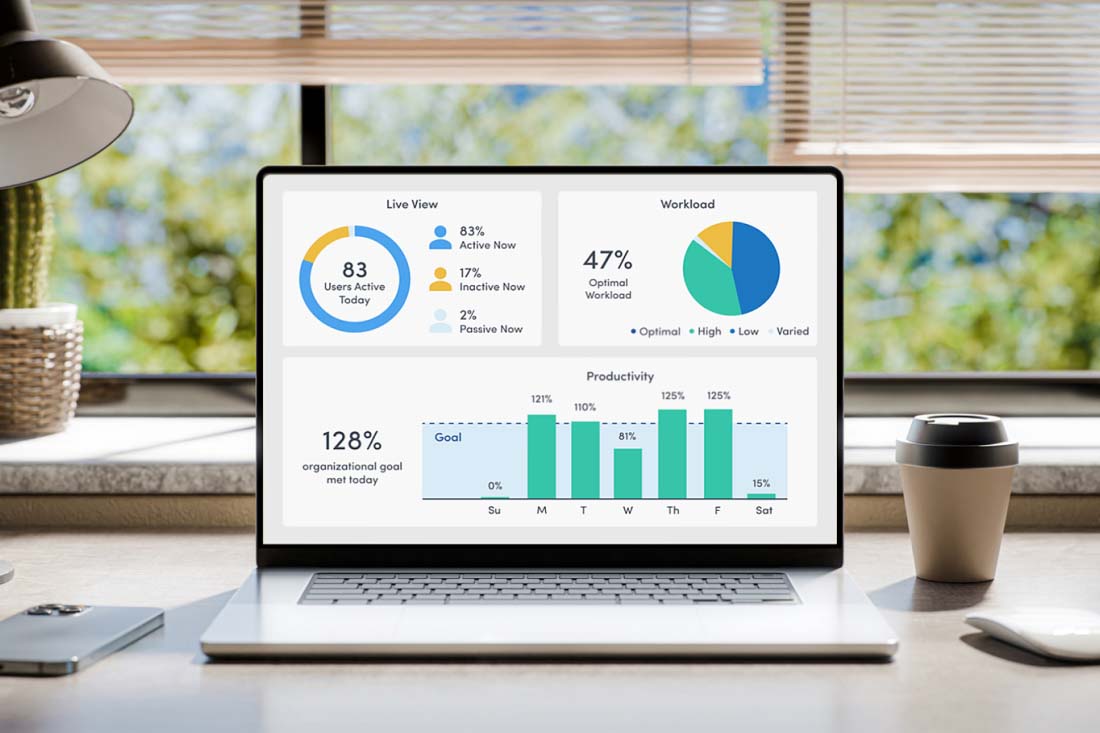For most companies, the recent surge in remote work has presented new challenges that need to be addressed immediately. One of the biggest challenges is keeping teams connected and productive, especially when you can’t have in-person meetings. Luckily, technology is keeping up by offering a range of tools that help remote team members stay connected even when they go weeks without seeing each other at an office.
Check out our list of must-have remote tools to help your team stay productive — and improve other business areas — no matter where they work.
Key Takeaways
- Most remote work tools fall into one of six key categories
- To make remote teams more productive and secure, managers must select the best tool (or tools) for their team within each category
- Remote work monitoring software makes it easy to see how employees actually use your tools — and if they’re effective
Types of remote work tools
The market is flooded with tools for remote teams. Some make it easier to manage projects, others are designed for video calling or instant messaging. Here are the most popular categories of remote work tools:
- Productivity and time management
- Communication and collaboration
- Security and privacy
- Project management
- File sharing and cloud storage
- Hardware and equipment
So how do you decide which ones work best for your team? Start by looking at the different areas of remote team management. This will help you narrow down a long list of options to one or two in each category. Key features include:
Productivity and time management
Worried your remote employees struggle to stay on task? The jury’s still out on whether remote work makes employees more productive, and many managers need hard data to show that teams are accomplishing their tasks on time and hitting targets. This is where productivity and time management tools like ActivTrak come in. Look for software that goes beyond time tracking to measure employee productivity and engagement, so you can spot issues like burnout and overwhelm.
Communication and collaboration
A common problem for remote workers is keeping the team connected when everyone works from home. Which is why finding the right tools to support communication and collaboration is essential. Whether it’s a video chat tool like Zoom or a digital collaboration app like Slack, this software makes working from home much more efficient.
Security and privacy
Another issue all remote teams face is security and privacy. Having a workforce located in a single location makes it easier to maintain firewalls or implement security features that keep the network safe. But remote workers often connect to unsecured Wi-Fi networks or leave equipment in less secure locations. Password managers, VPNs and data loss protection tools help prevent security breaches — as do employee monitoring solutions.
Project management
The smoother the workflow, the faster a team achieves goals. But for remote teams, success hinges on having the right digital tools. Project management tools like Asana and Trello keep everyone on the same page, whether you work with a remote team of five or 50. These tools make it easy to set deadlines, assign tasks and track progress.
File sharing and cloud storage
Quick, seamless access to files is essential for any remote team. Tools like OneDrive and Google Drive make it easy to store and share documents online, from anywhere. Look for solutions that offer plenty of storage space as well as security controls. This ensures fast, easy access while keeping your sensitive data secure.
Hardware and equipment
Don’t forget about physical workspaces! Yes, remote teams collaborate digitally. But they also need reliable devices and environments to do so effectively. As you evaluate different tools for remote work, think about how you’ll deliver those tools. In addition to corporate laptops, consider offering stipends to support high-speed internet connections and strong mobile hotspots.
16 must-have remote work tools
1. ActivTrak
If you’re looking for a total view of your remote team’s productivity, ActivTrak is your first stop. From tracking time spent in apps to identifying inefficient workflows, this software helps you see how remote employees work — and what you can do to help them work better. It provides remote managers with much-needed visibility on everything from workload distribution to how employees spend their time, and provides dashboards that make it easy to put the data to use.
2. Google Calendar
Google Calendar is a great option for remote teams looking to share and manage schedules across geographic locations or time zones. You can also use it to schedule video calls with Google Meet, sync with other calendars and even automatically add event details from email. The app integrates with a lot of other technology, making it easy for remote teams to stay connected and organized.
3. Todoist
Todoist is a task management tool with a user-friendly interface that’s made it a popular option for remote teams. While you can use it as a simple way to track your to-do list, its reminders, due dates, priorities, labels and integrations make it ideal for remote project management, too. It includes a Smart Schedule feature that automatically tells you when the best time to do what projects will be, based on those priorities and due dates.
4. Trello
As one of the most popular project management tools, Trello is a simple (and usually affordable) way for remote teams to track projects. Similar to Asana and Monday.com, Trello allows you to assign tasks to team members through cards, called kanban. The tool provides additional opportunities for file sharing and collaboration on assignments and deadlines. A drag-and-drop functionality and visual-based organization make it easy to use for most project managers and teams. Plus, the paid plan offers a lot of helpful features.
5. Smartsheet
While it may look like a spreadsheet, Smartsheet does so much more. Many remote teams use it to automate workflows, build and manage forms, create tickets and more. It also offers native integrations for dozens of popular work applications, and offers intelligent workflows to help remote team members manage project tasks across multiple technology stacks. If you’re already using a spreadsheet to track your projects, Smartsheet should provide an easy transition.
6. Asana
Asana is a popular kanban-based remote team management platform that helps teams organize, track and manage work. Similar to Trello, you can assign tasks to colleagues and upload files. However, Asana offers more flexibility in terms of visualization, with lists, timelines, calendars, Gantt charts and workflows.For this reason, many remote teams rely on it to keep projects on track — and to ensure everyone on the team has full visibility.
7. Monday.com
Another project management tool, Monday.com offers similar features to Asana and Trello but is even more customizable. The platform provides more file-sharing options and space for uploads, plus form creation and automation options. It’s also cloud-based, making it simple for remote employees to access from anywhere. The interface is intuitive, with different viewing options to suit the various needs of individual remote workers
8. Zoom
The king of video calls is Zoom, which took off during the COVID-19 pandemic and is still a popular tool for remote workers. The app provides calendar syncing to make it easier to schedule meetings — even across time zones — as well as screen sharing and other video call tools. Zoom is also a great tool for virtual conferences or webinars, although the free version limits call times to 45 minutes and a set number of participants.
9. Slack
As a chat client, Slack is an extremely popular app for remote team communication. But the tool also allows for collaboration, including integrations with file sharing programs and project management tools. Beyond just sending each other messages, team members can hold meetings, share calendars and even work on projects within the app. As an added bonus, users can log into multiple Slack accounts in one app — ideal for remote teams that include contractors or freelancers who may be members of multiple organizations, or for agencies with multiple clients.
10. Google Drive
Google Drive is a great option for simple, cloud-based file sharing. It integrates with other Google apps like Google Docs, Google Sheets and Google Calendar for real-time collaboration and file tracking. Google is known for being easy to use with a short learning curve, and Google Drive’s drag and drop functionality is no different. The system makes it easier to keep track of documents, spreadsheets and other items, even with multiple collaborators spread across numerous locations. And it integrates with a number of other software tools to make it easier to get work done faster.
11. Microsoft Teams
Microsoft Teams is a full-blown communication platform used by major corporations, government organizations and schools. It’s also a great option for remote teams looking to improve collaboration. The tool allows for video conferencing, chat and collaboration on documents and spreadsheets — making it a central hub for remote teams to stay connected and productive
12. LastPass
One of the biggest security risks for remote teams? Weak passwords. LastPass solves this issue by equipping employees with a password vault that uses “military-grade encryption.” Simply have the tool generate and organize tough-to-crack passwords, then use it to automatically log into various apps and websites. LastPass offers two-factor authentication (2FA) and biometric logins to help ensure password safety, and even alerts employees when passwords may be at risk. You can use LastPass on any device or browser; all you have to do is remember your master password.
13. Dashlane
Dashlane Password Manager is another password vault that encrypts data to help remote teams keep hackers at bay. It uses 256-bit encryption, offers 2FA and provides biometric identification. It also offers business plans with additional support for remote teams, such as admin controls and threat detection, to help prevent data breaches. Dashlane is a good option for organizations with large distributed teams, since it provides visibility into how employees use passwords as well as real-time security alerts.
14. NordVPN (Or NordLayer for Enterprise)
A virtual private network is a smart way to manage remote employee access to sensitive information by hiding browser details. VPNs also make it harder for hackers to monitor activity — a big threat when remote employees use unsecure public Wi-Fi. NordVPN is a popular service that offers traffic routing, file sharing and built-in antivirus tools. While they don’t offer a free version, they work to make their somewhat pricey platform worth it for business users. The VPN helps IT and security professionals manage malware monitoring and block malicious sites so employees can work securely, no matter where they’re located.
15. Perimeter 81
Perimeter 81 is a cloud-based VPN solution known for easy implementation. It boasts quick deployment and world-class support, along with a promise to get your remote network set up and running in as little as 20 minutes. They don’t offer a free plan, and they’re definitely not the cheapest VPN in the business, but they offer a number of security features and user management tools to secure your organization’s data and keep your employees safe from attacks and data breaches.
16. Forcepoint DLP
If you work in a highly regulated industry such as healthcare, government contracting or financial services, data loss protection (DLP) should be one of your top priorities. Forcepoint DLP is a software solution that protects data and intellectual property for businesses, focusing on “human-centered” risks. The software identifies sensitive data, monitors your team for leaks, protects data as it’s transferred across platforms, secures stored data and protects data while teams are using it.
Manage your remote workforce with ActivTrak
If you’re looking for data on how your remote team is performing from a productivity standpoint, ActivTrak is the platform you need. Get insight into where employees spend the most time and when they’re most productive, plus what tools help (or hinder) their work. More than 9,500 remote and hybrid organizations also rely on ActivTrak to:
- Monitor employee engagement with AI-powered insights to surface patterns and burnout risks
- Optimize the workforce by identifying skills gaps and unused employee capacity
- Manage employee performance with tailored insights to guide coaching conversations
Schedule a free demo today to see how ActivTrak can help your teams reach their best productivity goals.





